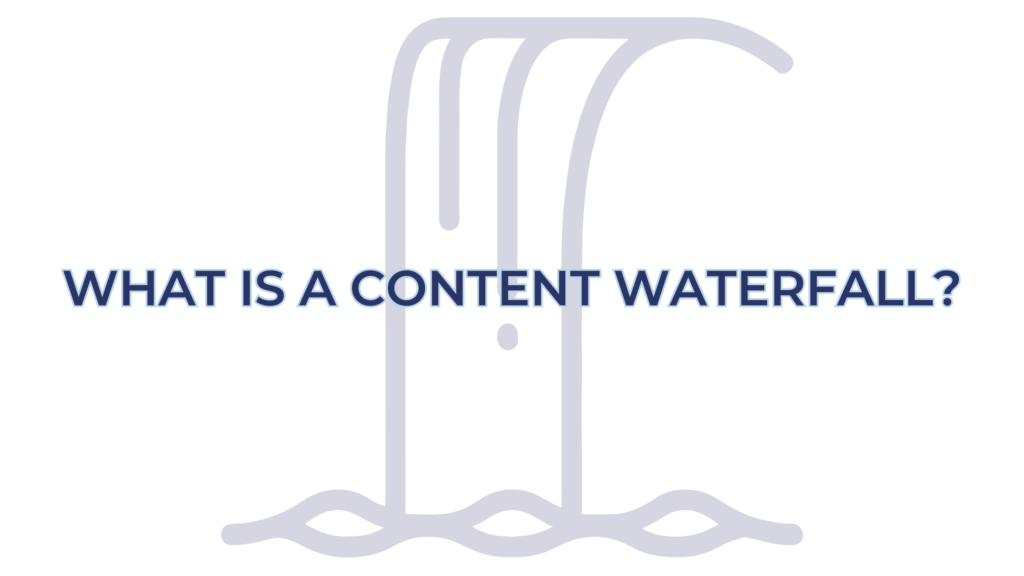
What is a Content Waterfall?
The Content Waterfall strategy is a systematic approach to content creation that maximizes the reuse and repurposing of content to extend its lifespan and amplify its reach. This methodology emphasizes creating a large, cornerstone piece of content—such as a whitepaper, research report, or long-form article—that can be broken down into smaller, more digestible content pieces distributed across various channels over time. The key idea is to create content once and then “waterfall” it into multiple formats, thereby reducing the effort required for continuous content creation and improving overall content efficiency.
This strategy is particularly useful for businesses that need to maintain a steady stream of content across multiple platforms but have limited resources or time for constantly creating new materials.
How the Content Waterfall Works
- Cornerstone Content Creation: At the core of the content waterfall strategy is a primary, in-depth piece of content, often referred to as “cornerstone” or “pillar” content. This could be a whitepaper, research report, comprehensive guide, or in-depth blog post. The goal is to create a robust, long-form piece of content that covers a topic comprehensively and can be used as a foundation.
- Breakdown into Micro-Content: Once the cornerstone content is created, it can be repurposed into smaller, micro-content pieces. This could include social media posts, infographics, short blog articles, or even videos. Each of these smaller content pieces offers a different angle or extract from the original content, allowing for broader distribution across platforms.
- Cross-Channel Distribution: These micro-content pieces are then distributed across various marketing channels, such as social media, email newsletters, podcasts, and more. Each format is tailored to suit the platform’s audience and user preferences. By repurposing content for different platforms, the same core message is reinforced across multiple touchpoints, increasing brand awareness.
- Optimization and Reuse: The final step in the content waterfall strategy involves continuous optimization and reuse. Marketers can track the performance of the micro-content and further refine it to create even more iterations. This allows businesses to make the most of the content they’ve already produced, extending its shelf life while maintaining relevancy.
For a deeper look at the step-by-step process, see this breakdown on FocusWorks Marketing.
Why is the Content Waterfall Important?
- Maximizes Content Efficiency: One of the main benefits of the content waterfall approach is that it maximizes the mileage of a single piece of content. Instead of producing content for each individual channel from scratch, businesses can repurpose and adapt content, significantly reducing time and effort. This makes it ideal for smaller teams or businesses with limited resources.
- Consistency Across Channels: The waterfall approach ensures consistent messaging across different platforms. By using the same cornerstone content as the foundation, each micro-content piece reinforces the core message, creating a unified content marketing strategy.
- Improved SEO Performance: Repurposing content into different formats helps increase a brand’s digital footprint. For example, turning a blog post into social media snippets, an infographic, and a podcast episode allows the content to be indexed across multiple channels, improving SEO rankings. It also increases the likelihood of backlinks and shares, further enhancing search visibility.
- Reduces Content Fatigue: Constantly creating new content can lead to burnout for content creators and fatigue for the audience. The waterfall approach offers a solution by reusing valuable content in different ways, keeping the audience engaged without overwhelming the content team with constant production demands.
Drawbacks of the Content Waterfall
- Risk of Overuse: One potential downside is the risk of over-repetition. If content is repurposed without variation, audiences may become disengaged if they feel they’re seeing the same message repeatedly.
- Initial Investment: While the content waterfall strategy saves time in the long run, it requires a significant initial investment in the creation of high-quality cornerstone content. If this initial piece is not well-researched or valuable, the entire waterfall strategy will suffer.
- Audience Segmentation Needs: Different platforms cater to different audience segments. Adapting a single piece of content for diverse audiences can sometimes feel forced or may not resonate with each segment if not tailored appropriately.
Working with a Content Agency to Develop a Content Waterfall
A content agency can help implement the content waterfall strategy by identifying cornerstone topics, producing long-form content, and repurposing it for multiple platforms. Agencies bring the expertise to ensure that each piece of micro-content is adapted effectively for different channels while maintaining consistency in the messaging.
By working with a content agency, businesses can maximize the value of their content, maintain a steady content flow, and reach broader audiences with less effort over time.
